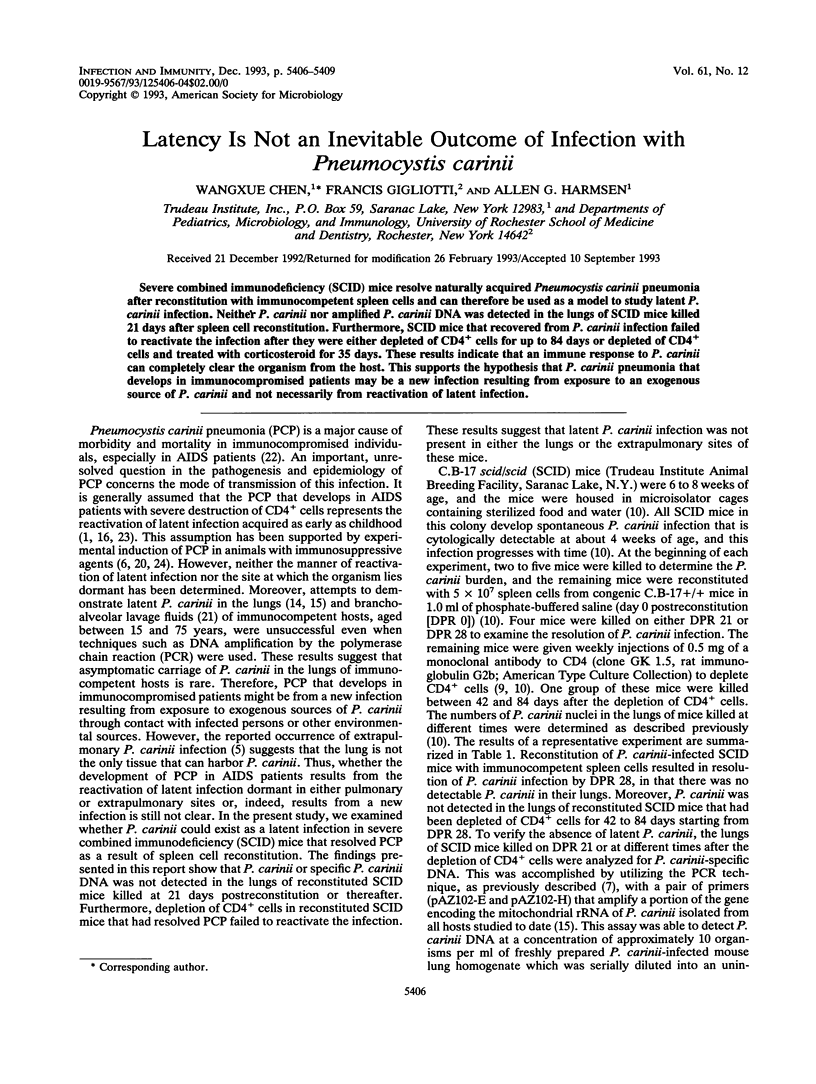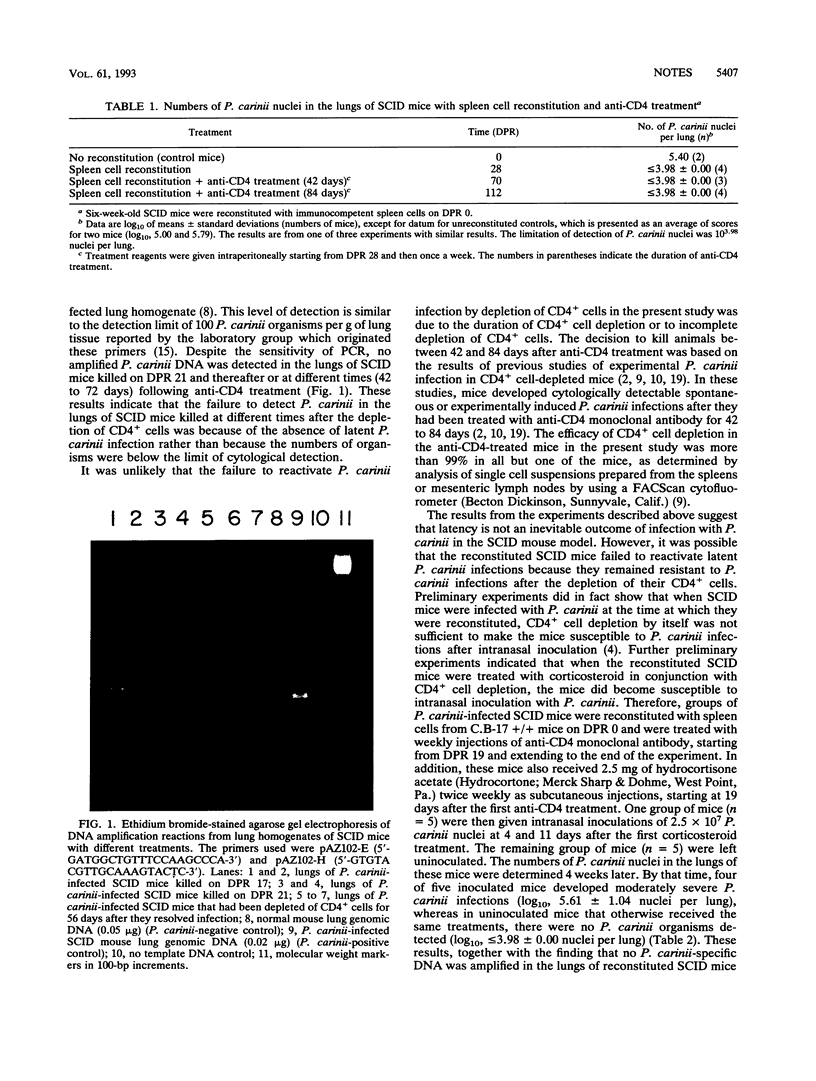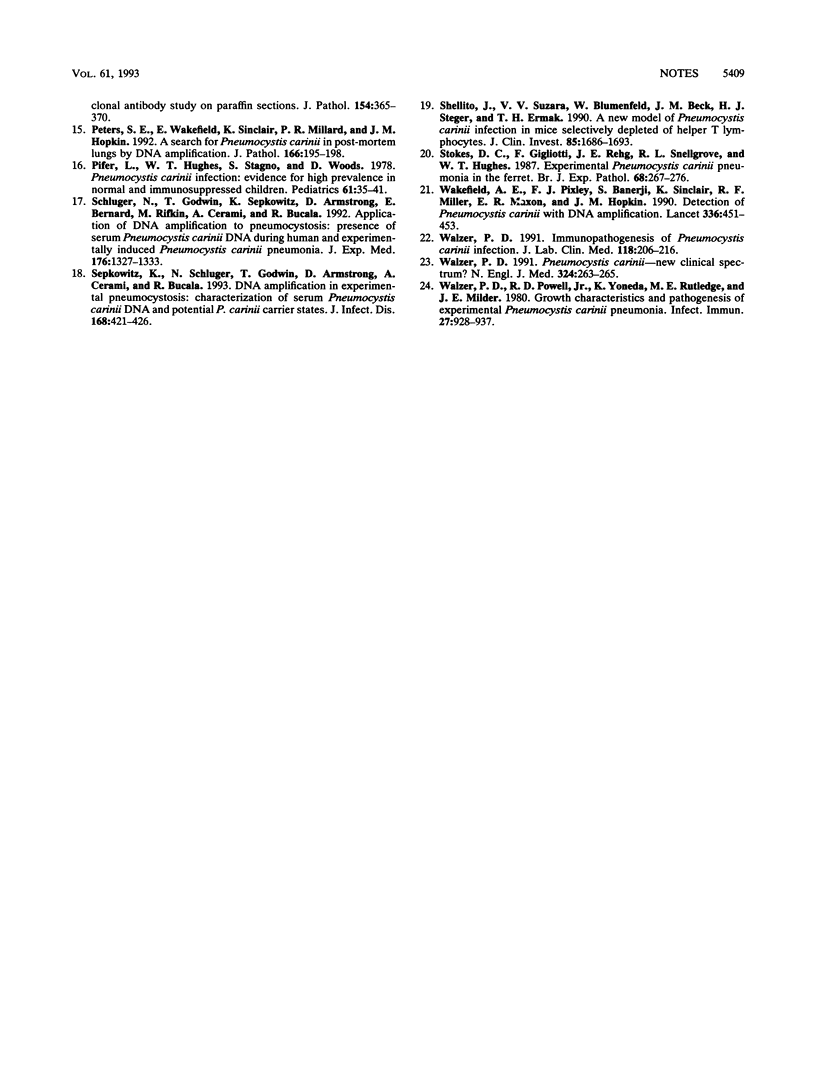Abstract
Severe combined immunodeficiency (SCID) mice resolve naturally acquired Pneumocystis carinii pneumonia after reconstitution with immunocompetent spleen cells and can therefore be used as a model to study latent P. carinii infection. Neither P. carinii nor amplified P. carinii DNA was detected in the lungs of SCID mice killed 21 days after spleen cell reconstitution. Furthermore, SCID mice that recovered from P. carinii infection failed to reactivate the infection after they were either depleted of CD4+ cells for up to 84 days or depleted of CD4+ cells and treated with corticosteroid for 35 days. These results indicate that an immune response to P. carinii can completely clear the organism from the host. This supports the hypothesis that P. carinii pneumonia that develops in immunocompromised patients may be a new infection resulting from exposure to an exogenous source of P. carinii and not necessarily from reactivation of latent infection.
Full text
PDF



Images in this article
Selected References
These references are in PubMed. This may not be the complete list of references from this article.
- Bartlett M. S., Smith J. W. Pneumocystis carinii, an opportunist in immunocompromised patients. Clin Microbiol Rev. 1991 Apr;4(2):137–149. doi: 10.1128/cmr.4.2.137. [DOI] [PMC free article] [PubMed] [Google Scholar]
- Beck J. M., Warnock M. L., Curtis J. L., Sniezek M. J., Arraj-Peffer S. M., Kaltreider H. B., Shellito J. E. Inflammatory responses to Pneumocystis carinii in mice selectively depleted of helper T lymphocytes. Am J Respir Cell Mol Biol. 1991 Aug;5(2):186–197. doi: 10.1165/ajrcmb/5.2.186. [DOI] [PubMed] [Google Scholar]
- Blumenfeld W., McCook O., Holodniy M., Katzenstein D. A. Correlation of morphologic diagnosis of Pneumocystis carinii with the presence of pneumocystis DNA amplified by the polymerase chain reaction. Mod Pathol. 1992 Mar;5(2):103–106. [PubMed] [Google Scholar]
- Cohen O. J., Stoeckle M. Y. Extrapulmonary Pneumocystis carinii infections in the acquired immunodeficiency syndrome. Arch Intern Med. 1991 Jun;151(6):1205–1214. [PubMed] [Google Scholar]
- Frenkel J. K., Good J. T., Shultz J. A. Latent Pneumocystis infection of rats, relapse, and chemotherapy. Lab Invest. 1966 Oct;15(10):1559–1577. [PubMed] [Google Scholar]
- Gigliotti F., Haidaris P. J., Haidaris C. G., Wright T. W., Van der Meid K. R. Further evidence of host species-specific variation in antigens of Pneumocystis carinii using the polymerase chain reaction. J Infect Dis. 1993 Jul;168(1):191–194. doi: 10.1093/infdis/168.1.191. [DOI] [PubMed] [Google Scholar]
- Gigliotti F., Harmsen A. G., Haidaris C. G., Haidaris P. J. Pneumocystis carinii is not universally transmissible between mammalian species. Infect Immun. 1993 Jul;61(7):2886–2890. doi: 10.1128/iai.61.7.2886-2890.1993. [DOI] [PMC free article] [PubMed] [Google Scholar]
- Harmsen A. G., Chen W. Resolution of Pneumocystis carinii pneumonia in CD4+ lymphocyte-depleted mice given aerosols of heat-treated Escherichia coli. J Exp Med. 1992 Sep 1;176(3):881–886. doi: 10.1084/jem.176.3.881. [DOI] [PMC free article] [PubMed] [Google Scholar]
- Harmsen A. G., Stankiewicz M. Requirement for CD4+ cells in resistance to Pneumocystis carinii pneumonia in mice. J Exp Med. 1990 Sep 1;172(3):937–945. doi: 10.1084/jem.172.3.937. [DOI] [PMC free article] [PubMed] [Google Scholar]
- Hughes W. T., Bartley D. L., Smith B. M. A natural source of infection due to pneumocystis carinii. J Infect Dis. 1983 Mar;147(3):595–595. doi: 10.1093/infdis/147.3.595. [DOI] [PubMed] [Google Scholar]
- Hughes W. T. Natural mode of acquisition for de novo infection with Pneumocystis carinii. J Infect Dis. 1982 Jun;145(6):842–848. doi: 10.1093/infdis/145.6.842. [DOI] [PubMed] [Google Scholar]
- Jacobs J. L., Libby D. M., Winters R. A., Gelmont D. M., Fried E. D., Hartman B. J., Laurence J. A cluster of Pneumocystis carinii pneumonia in adults without predisposing illnesses. N Engl J Med. 1991 Jan 24;324(4):246–250. doi: 10.1056/NEJM199101243240407. [DOI] [PubMed] [Google Scholar]
- Millard P. R., Heryet A. R. Observations favouring Pneumocystis carinii pneumonia as a primary infection: a monoclonal antibody study on paraffin sections. J Pathol. 1988 Apr;154(4):365–370. doi: 10.1002/path.1711540413. [DOI] [PubMed] [Google Scholar]
- Peters S. E., Wakefield A. E., Sinclair K., Millard P. R., Hopkin J. M. A search for Pneumocystis carinii in post-mortem lungs by DNA amplification. J Pathol. 1992 Feb;166(2):195–198. doi: 10.1002/path.1711660217. [DOI] [PubMed] [Google Scholar]
- Pifer L. L., Hughes W. T., Stagno S., Woods D. Pneumocystis carinii infection: evidence for high prevalence in normal and immunosuppressed children. Pediatrics. 1978 Jan;61(1):35–41. [PubMed] [Google Scholar]
- Schluger N., Godwin T., Sepkowitz K., Armstrong D., Bernard E., Rifkin M., Cerami A., Bucala R. Application of DNA amplification to pneumocystosis: presence of serum Pneumocystis carinii DNA during human and experimentally induced Pneumocystis carinii pneumonia. J Exp Med. 1992 Nov 1;176(5):1327–1333. doi: 10.1084/jem.176.5.1327. [DOI] [PMC free article] [PubMed] [Google Scholar]
- Sepkowitz K., Schluger N., Godwin T., Armstrong D., Cerami A., Bucala R. DNA amplification in experimental pneumocystosis: characterization of serum Pneumocystis carinii DNA and potential P. carinii carrier states. J Infect Dis. 1993 Aug;168(2):421–426. doi: 10.1093/infdis/168.2.421. [DOI] [PubMed] [Google Scholar]
- Shellito J., Suzara V. V., Blumenfeld W., Beck J. M., Steger H. J., Ermak T. H. A new model of Pneumocystis carinii infection in mice selectively depleted of helper T lymphocytes. J Clin Invest. 1990 May;85(5):1686–1693. doi: 10.1172/JCI114621. [DOI] [PMC free article] [PubMed] [Google Scholar]
- Stokes D. C., Gigliotti F., Rehg J. E., Snellgrove R. L., Hughes W. T. Experimental Pneumocystis carinii pneumonia in the ferret. Br J Exp Pathol. 1987 Apr;68(2):267–276. [PMC free article] [PubMed] [Google Scholar]
- Wakefield A. E., Pixley F. J., Banerji S., Sinclair K., Miller R. F., Moxon E. R., Hopkin J. M. Detection of Pneumocystis carinii with DNA amplification. Lancet. 1990 Aug 25;336(8713):451–453. doi: 10.1016/0140-6736(90)92008-6. [DOI] [PubMed] [Google Scholar]
- Walzer P. D. Immunopathogenesis of Pneumocystis carinii infection. J Lab Clin Med. 1991 Sep;118(3):206–216. [PubMed] [Google Scholar]
- Walzer P. D. Pneumocystis carinii--new clinical spectrum? N Engl J Med. 1991 Jan 24;324(4):263–265. doi: 10.1056/NEJM199101243240411. [DOI] [PubMed] [Google Scholar]
- Walzer P. D., Powell R. D., Jr, Yoneda K., Rutledge M. E., Milder J. E. Growth characteristics and pathogenesis of experimental Pneumocystis carinii pneumonia. Infect Immun. 1980 Mar;27(3):928–937. doi: 10.1128/iai.27.3.928-937.1980. [DOI] [PMC free article] [PubMed] [Google Scholar]



